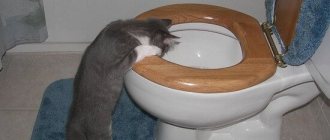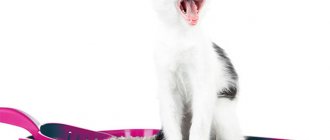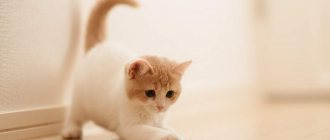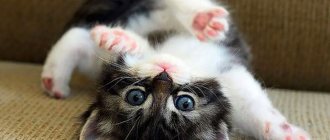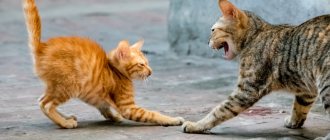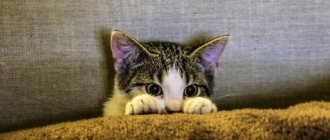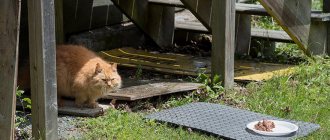8805Pavel
The appearance of a small kitten in the house is, of course, a joyful event. Now he will wait for the owner to arrive, fall asleep on his lap, purr in his palms and ask to play. He comes to the house to live in it and please the person. And a person must prepare a home for this defenseless baby so that he will be happy in it. Here are detailed tips on what a kitten needs and how to choose it.
First of all, the kitten will need a place where it will sleep, eat and go to the toilet. We must remember that he is a living being with his own needs.
© shutterstock
For growth and development, he must eat well and drink clean water. Therefore, it is better to immediately buy two different bowls - a deeper one for water, a flat one for food. Best suited :
- glass,
- earthenware,
- enameled.
Bacteria grow very quickly in plastic ones, which lead to the appearance of untidy black marks on the face. If buying a separate cat bowl is expensive, then an old small salad bowl for water and a saucer for food will do just fine.
By the way, food should be bought in bags with the kitten’s age already indicated. It contains everything a growing body needs and has a long shelf life. It’s better to immediately, before the kitten arrives, buy several different bags, especially since their price is modest - about 10 rubles . Over time, your pet will develop taste preferences. Bottled drinking water is suitable. It needs to be changed as often as possible, avoiding stagnation, depending on the contamination, 2-3 times a day.
Toiletries
This category includes the tray, filler and hygiene products.
The tray should be easy to use. The easier it is for a kitten to use the litter box, the more willing he will be to go in it. You need to place the tray in a quiet place where no one will disturb the kitten when it is busy there.
It’s better to start by buying the same filler The usual filler will not cause additional stress for the pet; he will know exactly what to do. When the kitten gets used to its new home, the litter can be gradually changed to another.
A scoop for cleaning the tray is often sold along with the tray.
A hygiene product for the tray is needed to regularly wash the tray before completely changing the filler. Give preference to products without strong odors. Due to the strong unpleasant smell of chemicals, the kitten may stop going to the litter box.
A remedy for the smell of urine may be needed at first, when the kitten has not yet remembered where its litter box is located. Special products can be purchased at a pet store.
List of basic items a kitten needs
The acquisition of a small furry creature always evokes bright, joyful emotions.
It should be taken into account that a kitten is not a toy and requires the creation of full, safe living conditions. First of all, buy the animal:
- Bowls. It is recommended to purchase 3 pieces at once - one for food, two for drinking.
- A tray that functions as a cat litter box.
- Filler. Natural, completely safe substances are selected for children.
- Products for hair care and hygiene procedures (combs, shampoo, nail clipper).
- Scratching post. This device helps protect property from scratching. You can buy it at a pet store or make it yourself.
- House. The cat accessory will serve as a sleeping place and will help to avoid falling asleep in undesirable places.
- Carrying bag. The accessory is indispensable when visiting the veterinarian, exhibitions, and while traveling.
The person who becomes the owner of a furry baby takes responsibility for his life and health. Good nutrition for the animal, care, entertainment, rest, and sleep will be mandatory. To ensure that adaptation to a new place goes without problems, it is best to buy all the kitten’s supplies in advance.
Cat bowls
It is convenient for kittens to eat from a bowl that has medium depth. It is better if the drinking container is deeper. It is undesirable to use plastic utensils. Firstly, such devices are not hygienic, and secondly, they sometimes cause allergic reactions.
First of all, steel or ceramic bowls are considered. They are safe and easy to clean. These bowls have considerable weight, which prevents them from tipping over.
Dishes need to be cleaned daily. You will need to ensure that the pet always has access to fresh water, even in the absence of its owners.
Tray selection
The tray is placed in secluded places. This will help the baby overcome his fear of a new toilet and adapt to it faster. The first tray for a kitten should be shallow or have a recess.
It is useful to consider the following:
- for shy animals it is better to purchase a closed toilet;
- For those who like to turn over the filler, a tray with high sides is suitable.
It is not advisable to purchase expensive options. The cat will grow up quickly, and the owner will soon need to buy a device for an adult.
The cat litter is updated daily. It is washed thoroughly every week. After washing, rinse the tray well and dry it. If you don't keep the litter box clean, your cat will refuse to use it.
Toilet filler
The rule that animal owners adhere to first of all is to use a litter that is already familiar to the kitten. However, if its cost turns out to be too high, an absorbent composition from among less expensive analogues will do.
It is recommended to avoid mineral filler. If the kitten eats it, the risk of blockage in the digestive tract increases. Also, you should not purchase sand options. Many cats love to throw sand and create a constant mess.
It is best to buy cat litters that have good absorbent properties and can absorb unpleasant odors (silica gel, wood). They also use improvised means (sawdust, newspapers). However, these compositions are not able to fully absorb odors, and become only a temporary option.
Care products
Having the right accessories and other tools will help you always see your cat looking beautiful and healthy. An important point is the choice of comb. First of all, you should choose double-sided brushes made from natural bristles.
The animal needs to be brushed regularly. This will help avoid the appearance of tangles and improve the condition of the coat and skin. If the baby has long hair, the procedure is carried out 3-5 times during the week. Representatives of smooth-haired breeds need two or three brushings.
Human shampoo is not suitable for cats. You can only buy a suitable bath product for your kitten at a veterinary store. The frequency of water procedures is once every two weeks. Sometimes (if there is heavy pollution on the street, during molting, or if it is infected with parasites), your pet should be bathed more often.
A nail clipper is a special veterinary device used to trim cat claws. For cats with thin claws, nail clippers or scissors are suitable.
scratching post
Having a scratching post has obvious benefits.
This device helps a growing cat:
- relieve accumulated stress;
- expend excess energy;
- reproach claw renewal.
Regular use of the scratching post helps your pet maintain physical fitness. In the absence of an accessory, the animal can sharpen its claws on sofas, armchairs, and carpets, upsetting the owners.
Pet stores offer different models of scratching posts. First of all, choose flat products. Scratching posts-toys in the form of cylinders that roll on the floor are also used. If a cat often visits a certain corner, its owner should buy a wall-mounted corner scratching post and arrange it here.
cat house
Having a personal house will give the kitten a feeling of comfort, security, and help cope with fears. The presence of such an item will help avoid the widespread appearance of wool.
When choosing an accessory, consider the following:
- the structure must be stable;
- you need to choose products with a base made of natural materials;
- the house is placed low, as close as possible to the floor surface, from where the cat can easily penetrate it;
- It is worth equipping the accessory with additional elements that arouse the animal’s interest (hammock, tunnels, hanging toys, baskets).
On the shelves of pet stores you can find many such structures (wooden, wicker, cardboard, nesting houses, multi-story options). If the financial condition of the owners prevents them from purchasing a finished house, they make it themselves.
Carrying bag
When leaving its usual habitat, going on a hike or a trip, a pet always experiences excitement. He experiences severe stress when meeting strangers, animals, or during his first visit to the veterinarian. The carrier allows you to comfortably transport the kitten, without stressful experiences.
The carrying bag must be spacious, have a hard bottom, viewing windows, and adequate ventilation. It is welcome to have strong handles and reliable locks that prevent the animal from escaping or falling out. In order not to scare away the cat, choose products made from materials without a strong specific odor.
Today, a variety of carriers are produced. For long trips and protecting your pet from snow, wind, and rain, you should first of all buy a plastic version. Fabric and wicker bags will become indispensable when hiking in summer or spring.
Food and bowls
The kitten's food should be recommended by the breeder. At first, it is better to feed your baby his usual food, so he will not experience stress from changing food. When the kitten adapts to a new place, you can gradually change its diet. Especially for kittens, SUPERPET offers the Minced meat line: the line is designed for kittens up to two months and will help animals easily get used to a healthy diet from childhood.
Bowls should be such that it is easy for the baby to eat and drink from them. You can purchase smaller bowls for your kitten and later replace them with larger bowls. For water, you can purchase a special drinking fountain for cats. Many pets prefer to drink running water.
Treats are needed not only to pamper your pet. Treats are useful for raising a kitten - they can reinforce good behavior and be used during training. We recommend giving preference to natural treats without artificial ingredients.
House or place to sleep
It is not always necessary to arrange a personal house for a kitten so that it feels comfortable. Sometimes a warm blanket on a chair or an old knitted sweater is enough. The main thing is that it is dry, warm and safe.
But still, so that the cat later knows its place in which it can sleep, it is better to buy a house. This will solve the problem of falling asleep on clean or ironed items or wool on them.
The house for the kitten to appear and live in should be chosen to be soft, made of natural fabrics in soothing colors. You definitely need an entrance, without curtains or doors, to ventilate it. The place to sleep should be regularly fried in the sun and washed.
Beds and cat trees
a lounger so that the kitten can hide there if desired. When choosing a lounger, consider how easy it is to clean and whether it can be washed.
A cat tree is especially useful if you have chosen an active breed kitten. These pets love to climb and jump, and a cat tree will be great entertainment for them.
Scratching posts are needed to prevent your pet from scratching the furniture. Using the dot not only grinds down cats' claws, it relieves stress and marks their territory. Therefore, it is advisable to install not one, but several scratching posts.
Feeding at first
To briefly touch on the issue, the criteria that are followed are as follows:
- The food should be appropriate for the age of the kitten.
- The number and volume of feedings are selected according to the instructions on the package.
- Try different food options to determine your taste preferences.
- Change the water frequently (3 times a day).
- Food residues must be removed in a timely manner so as not to lead to poisoning.
- The food on the owner's menu is not suitable for the animal. Having decided to feed natural products, the owner should know the specifics of its preparation, taking into account the breed, age and diet of the cats.
- Dry food is recommended to be introduced from 2 months of age.
Toys
Games help the kitten expend excess energy. When a kitten has enough entertainment in the form of toys, he is less likely to damage furniture, bite his hands, or jump on his feet to get attention.
Fishing rods with feathers are perfect for hunting games. Don't forget that cats are predators; they have a well-developed hunting instinct. The fishing rod is long enough to prevent the kitten from biting your hand while playing.
Balls and mice can be used for playing together, or can be left behind when you leave for work. If you wish, you can teach your baby to fetch a toy.
Interactive toys are advanced toys that you can leave with your kitten when you are not at home. Often these toys make sounds or move themselves, which arouses additional interest in pets.
Educational toys are usually made to use treats. For example, it could be a ball with a hole from which pieces of treats fall out. Such toys keep your pet occupied for a while and stimulate his brain activity.
scratching post
If you don’t want to cut your nails or it’s not possible, then a specially equipped play corner will come to the rescue. You can buy it in a store, order it from a craftsman, or even make it yourself using a model from the Internet. In any case, it should be made from natural parts - wood, hemp, burlap. The parts are fastened with silicone glue or large nails with a decorative cap.
© shutterstock
Veterinarians advise paying attention to:
- No smell, there shouldn't be any. This will repel the kitten and become a source of allergies for the person.
- Strength. All parts must hold tightly, the edges are firmly sewn, and the shelves and pipes must withstand the pressure of an adult’s hand.
- Safety. All surfaces should be carefully smoothed with your palms to look for loose nails, staples, etc. If there is a piercing or scratching sensation, it will definitely damage either the mouth or the paw.
- Dimensions. The house should not be tiny so that the kitten does not get stuck or get bored.
Care products
The shampoo is useful for breeds that require regular baths. It's good to have shampoo in case your pet gets dirty in something. For such situations, it is better to buy shampoo in small quantities: cats usually do not need to be washed.
Nail clippers are a useful tool to make caring for your kitten's claws easier. Before trimming your nails, learn how to do it correctly and painlessly.
nail clipper
In their natural environment, cats often have to climb trees, so their claws wear down on their own. At home, the pet is forced to damage furniture and walls in order to solve its problem. A quality nail clipper will help bring him back to order. This hygiene item is an example of what a cat needs from the first weeks of his stay in the house.
Main types of nail clippers:
- guillotine. Consists of an area to place the claw, blade and trigger. The principle of operation is similar to the operation of terrible execution equipment. Easy to use, just be careful;
- pruner Resembles garden shears and consists of blades, handles, guards or stops;
- scissors. The simplest model, the principle of operation coincides with the features of ordinary household scissors.
Note! For a kitten, it doesn’t really matter which model will be used for trimming its claws, so when choosing, you should focus on your own preferences. Whichever version of the nail clipper the owner can handle is the one that should be chosen.
When purchasing a nail clipper, the owner needs to choose the model that is most convenient for him to use.
Frequent mistakes of new owners
A potential kitten owner should know what mistakes to avoid:
- Early weaning from mother. The optimal moment for weaning from the mother is 1.5–2 months, when the baby is vaccinated and accustomed to solid food and a tray.
- Too fast treatment against all parasites and vaccination. Having discovered fleas on a kitten, you need to let it adapt before taking measures to combat the bloodsuckers. The same goes for vaccinations.
- Abrupt transfer to another food. The diet is changed gradually on the 7th–10th day of the animal’s stay in the new home.
Source
What should you feed your cat?
The correct diet for a cat is meat
The main meat in a cat's diet should be lean beef, lamb, horse meat, and rabbit. Of course, the diet may include not only meat, but also offal. Meat and offal should be given raw.
- Fish is a necessary product in a cat's diet. Just like meat, it can be given raw three times a week. Small fish are best given whole, raw.
- Dairy products. It is recommended that your cat eat fermented milk products with a fat content of up to 9%. Cottage cheese, yogurt, and kefir are good for digestion.
- Vegetables in a kitten's diet. They can also be present in the diet if your cat likes it. It is also good to give greens.
- Eggs in a kitten's diet. They can be given raw along with dairy products. There is no need to separate the yolk or white.
- Bones in a cat's diet. It is good to feed small fish or chicken necks whole raw.
It is not recommended to mix dry or canned food and natural products, since the food already presupposes complete proper nutrition for the cat, and dysbacteriosis is possible when mixed.
At 1.5 months
Below we will consider how and what to feed a 1.5 month old kitten at home:
At this age, the pet can already feed on its own, and its diet should be balanced. At this age, the kitten can be fed:
- rolled oats and buckwheat porridges;
- vegetables (any vegetables, except potatoes, served boiled or raw);
- raw meat (low-fat varieties). Served raw, boiled or scalded with boiling water. Meat products make up from 60 to 80% of the total daily food volume.;
- boiled offal;
- cottage cheese - 30 g per day, preferably not fatty;
- raw fish, previously doused with boiling water (about 1 time every 7 days);
- greens (you can ask at the animal department).
How often should I feed?
Kids eat a lot, 5-6 meals a day is the norm. In general, a kitten should eat 120 g per day. The baby cannot eat this amount at once. If the kitten eats less than normal, then you should try changing the food. If the animal refuses food, it is better to contact a veterinarian.
Once the kitten reaches 2 months, you can feed it a little more - up to 180 g
At this moment, it is important to monitor the pet’s activity - more playful and active animals need more food.
If you are going away for the day and leaving your kitten alone, feed him before you leave and leave some food in his bowl and feed him more when you return.
Food additives
Do not neglect this important point - vitamins and supplements will have a beneficial effect on the kitten’s body.
From 1.5 months you can add to food:
- Kitzim;
- "Doctor Zoo";
- "Brevers";
- "Farmavit";
- "Biofar".
Before purchasing vitamins, consult with specialists. Veterinarians can advise you on which food supplements are best for your pet and whether your pet needs them at all. The most popular supplement for cats is fish oil. Veterinarians advise giving it 2 capsules for 7 days.
What not to give to a kitten
Every caring owner should remember the list of prohibited foods. Kittens should not eat:
- food with spices (the kind that people like);
- fatty meat: pork, beef;
- human medicines;
- sweets;
- river fish;
- legumes;
- fatty dairy products;
- flour;
- potatoes.
Is it possible to have ready-made food at 1.5 months?
Cat owners and veterinarians do not recommend mixing food and natural food. Many people primarily purchase ready-made cat food for a number of reasons:
- saving time;
- nutritional balance.
If you want to feed your pet food, you should consider that:
- it will not be possible to switch to natural nutrition;
- You cannot mix food of different brands, as they contain different microelements;
- Only high-quality commercial feed is suitable for feeding.
Choose high-quality, balanced food and your kitten will not have any health problems.
Kittens love wet food, but it's a little more expensive. However, according to veterinarians, dry, high-quality ones are more useful.
It is worth noting that wet food contains about 80% water, and your pet does not need to constantly drink water. With dry food, everything is different - there should always be a clean bowl with drinking clean water near the food bowl.
Veterinarians consider the following brands to be good food:
- Royal Canin;
- Almo Nature;
- Pro Plan Junior;
- Eukanuba Puppy Kitten.
The price tag may scare the kitten's owners, but believe me, by purchasing good food, you only win. You won’t have to buy additional vitamins, and the kitten will be healthy, and you won’t have to spend money on treatment.
Transporting your pet home
Invest in a cat carrier to make your pet's trip home more comfortable. Spraying synthetic feline hormones onto the carrier 4 times the day before transport will help your cat or kitten feel more confident during its first trip. Give preference to carriers that open at the top, they are more convenient.
The smell of an old toy or blanket from a previous home will help your cat feel less nervous. A trip, new smells and unfamiliar sounds will, of course, frighten and bother the cat. Meowing will also be an absolutely natural reaction - don’t take it too seriously, but try to limit the amount of irritants.
Cleaning your ears
To clean, you will need a cotton swab and boiled water at room temperature. You need to carefully clean the auricle from excess dirt and wax; you should not try to penetrate deep into the ear. We recommend reading the full information on how to clean your cat's ears.
You don’t need to clean your ear more than once a month and you don’t need to achieve sterility, just remove dirt. If you find that your cat often scratches his ear, you should show him to a doctor.
How to care for a cat?
Caring for a pet involves fulfilling several mandatory points:
Taking care of wool. The cat is combed (short-haired and without undercoat - once a week, long-haired - every 2-3 days) and bathed as needed. Hairless pets are wiped with a damp cloth.
Hygiene. 2-3 times a month, the ears are wiped with a damp swab (moistened with boiled water, chamomile infusion or a special lotion). Discharge from the eyes is regularly removed; brachycephalic animals (Persians, exotics, British) require special attention. Claws are trimmed as they grow
Teeth are brushed weekly (instead, you can give your pet special treats that cleanse teeth of plaque and prevent the formation of tartar).
Attention to health. Once every six months the animal must be shown to a veterinarian
During a preventive examination, a specialist will find out what vaccinations the cat needs to get according to its age, whether it’s time to treat the pet for fleas, etc., after which they follow all the recommendations given by the doctor.
Carrying
In order to transport a kitten from a breeder or its previous owner, a carrier is required. Don’t think that it’s easy to carry a cat in your bosom: he may get scared of something on the street, break free and run away. In the future, this accessory will help you when visiting a veterinarian or an exhibition, or when traveling with your pet. There are two types of carriers: plastic and fabric.
You should choose a hard plastic one if you are going to fly with your pet, as this is what the rules for transporting animals require. This type of carrier is also safer for transporting an animal by car. However, such a carrier will have to be insulated separately.
Soft fabric is more convenient if you plan to carry the cat yourself, on foot or by public transport. The disadvantage of this type of carrying is the need for washing.
